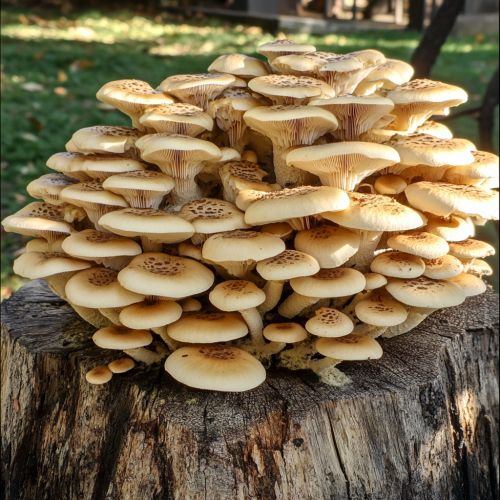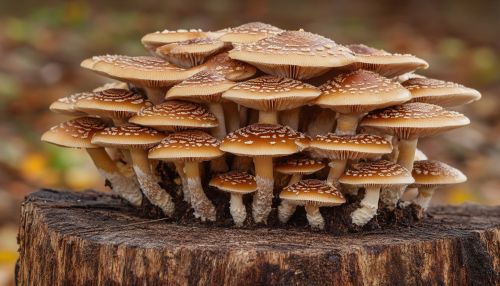Armillaria mellea
Description


Armillaria mellea, commonly known as honey fungus, is a species of fungus in the family Physalacriaceae. It is a pathogenic fungus that primarily affects woody plants, causing root rot and decay. This species is notable for its bioluminescent properties, where the mycelium emits a faint greenish light.
Taxonomy and Nomenclature
The species was first described by the Swedish mycologist Elias Magnus Fries in 1821. The genus name Armillaria is derived from the Latin word "armilla," meaning bracelet, referring to the ring around the stipe. The species epithet mellea means "honey-colored," which describes the typical coloration of the mushroom cap.
Morphology
Cap
The cap of Armillaria mellea ranges from 3 to 15 cm in diameter. It is convex when young, flattening out with age, and often has a central umbo. The surface is sticky when wet and varies in color from honey-yellow to reddish-brown. The cap is covered with fine scales, especially towards the center.
Gills
The gills are adnate to decurrent, crowded, and initially white, turning yellowish with age. They produce white spores.
Stipe
The stipe is 6 to 15 cm long and 1 to 2.5 cm thick, tapering towards the base. It is solid, fibrous, and has a persistent ring (annulus) near the top. The stipe's surface is smooth above the ring and scaly below.
Spores
The spores are white, smooth, and elliptical, measuring 7-9 by 5-6 micrometers. They are produced in large quantities, often forming a white spore print.
Ecology and Distribution
Armillaria mellea is found in temperate regions worldwide, including North America, Europe, and Asia. It thrives in a variety of habitats, including forests, woodlands, and gardens. The fungus is saprotrophic and parasitic, capable of decomposing dead wood and infecting living trees. It primarily targets hardwoods but can also affect conifers.
Pathogenicity
Armillaria mellea is a significant plant pathogen, causing Armillaria root rot. This disease affects a wide range of woody plants, leading to symptoms such as yellowing leaves, reduced growth, and eventual death. The fungus spreads through rhizomorphs, which are root-like structures that can travel through the soil to infect new hosts.
Life Cycle
The life cycle of Armillaria mellea includes both sexual and asexual reproduction. The fungus produces basidiospores on the gills of the fruiting body, which disperse and germinate to form new mycelium. The mycelium can also produce rhizomorphs, which allow the fungus to spread vegetatively.
Bioluminescence
One of the unique features of Armillaria mellea is its bioluminescence. The mycelium emits a faint greenish light, a phenomenon known as "foxfire." This bioluminescence is due to the enzyme luciferase acting on a substrate called luciferin in the presence of oxygen.
Economic and Ecological Impact
Armillaria mellea has significant economic and ecological impacts. In forestry and agriculture, it is considered a destructive pathogen, causing substantial losses. The fungus can kill mature trees, leading to reduced timber yields and increased management costs. Ecologically, it plays a role in nutrient cycling by decomposing dead wood, but its pathogenic nature can alter forest composition by selectively killing certain tree species.
Management and Control
Managing Armillaria mellea involves a combination of cultural, chemical, and biological methods. Cultural practices include removing infected stumps and roots, improving soil drainage, and selecting resistant plant species. Chemical control is limited due to the fungus's ability to survive in the soil for long periods. Biological control methods are being explored, including the use of antagonistic fungi and bacteria.
Edibility
Armillaria mellea is considered edible when cooked, but caution is advised as it can cause gastrointestinal upset in some individuals. The mushrooms should be thoroughly cooked to break down any potentially harmful compounds. In some cultures, it is a valued culinary ingredient, known for its firm texture and mild flavor.
